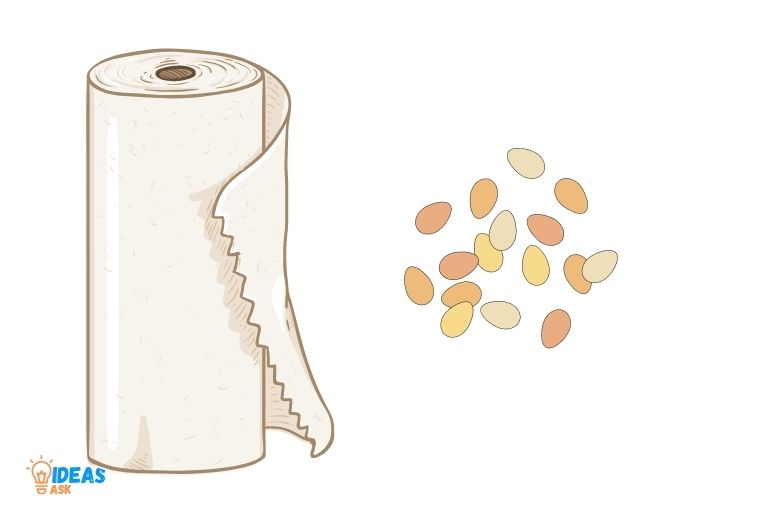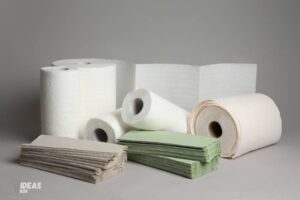Can You Germinate Lavender Seeds in Paper Towel? Yes!
Yes, you can germinate lavender seeds in a paper towel.
Germinating lavender seeds in a paper towel is a simple and effective method for starting these seeds. By using a paper towel, you provide the necessary moisture and warmth needed for the seeds to sprout and grow.
This method is also useful for monitoring the germination process and transplanting the seedlings without damaging their delicate roots.
To germinate lavender seeds in a paper towel, start by moistening the paper towel until it’s damp but not soaking wet. Next, spread the seeds evenly across the surface, leaving a little space between each seed.
Carefully fold the paper towel to cover the seeds and place it in a sealed plastic bag. Keep the bag in a warm location with temperatures between 65-75°F (18-24°C).
Check regularly for sprouting, which typically occurs within 1-3 weeks. Once seedlings have begun to develop, gently transplant them into small pots filled with well-draining soil.
Steps of Germinate Lavender Seeds in Paper Towel: Pros & Cons
| Method | Steps | Ideal Environment | Pros | Cons |
|---|---|---|---|---|
| Germinating Lavender Seeds in Paper Towel | 1. Moisten a paper towel<br>2. Spread lavender seeds evenly on the paper towel<br>3. Fold the paper towel to cover seeds<br>4. Place the folded paper towel inside a plastic bag and seal it<br>5. Place the bag in a warm and dark place<br>6. Check seeds daily for germination<br>7. Transplant germinated seeds to pots or garden | Warm (60-70°F/15-21°C)<br>Dark<br>Moist paper towel | – No soil needed<br>- Easier to monitor seed germination<br>- Reduced risk of seed rot | – Seeds may stick to paper towel<br>- Seedlings may become too delicate<br>- Requires transplanting after germination |
Key Takeaway

Five Facts About Germinating lavender seeds in Paper Towel
Understanding Lavender Seeds And Germination
Germinating lavender seeds can be a fun hobby and a rewarding experience, but it requires patience and proper techniques. Understanding lavender seeds and how they germinate is the first step towards successful seed growth.
In this section, we will delve into the process of lavender seed germination, the importance of proper germination techniques, and the factors that affect seed germination.
Introduction To Lavender Seeds
Before discussing germination, let’s get familiar with lavender seeds. Lavender seeds are small and delicate, similar to other herb seeds. They require a warm and moist environment to germinate.
Lavender seeds can take two to four weeks to sprout, and even up to several months to grow into a mature plant. It is important to be patient and diligent during the germination process to ensure successful growth.
The Process Of Seed Germination
The process of seed germination involves four main stages: seed activation, root emergence, shoot emergence, and seedling growth.
Here’s a breakdown of each stage:
- Seed activation: This stage is when the seed absorbs water and begins to activate. The seed coat softens, and the seed swells as it prepares to sprout.
- Root emergence: As the seed starts to grow, a small root will emerge from the seed and start to grow downward, anchoring the plant into the soil.
- Shoot emergence: Once the root is established, a shoot will emerge from the seed and start to grow upwards towards the soil surface.
- Seedling growth: As the shoot continues to grow, leaves will start to form, and the seedling will continue to mature into a full-grown plant.
Importance Of Proper Germination Techniques
Proper germination techniques are essential for successful growth.
Here are some of the reasons why:
- Consistent moisture: Lavender seeds require consistent moisture levels for optimal growth. If the soil is too dry, the seed will not germinate. Too much water can cause the seed to rot.
- Adequate light: Lavender seeds require adequate light to sprout and grow. After planting, place the seeds in a sunny spot to ensure proper photosynthesis.
- Temperature: Lavender seeds require warm temperatures to germinate. A consistent temperature of around 70°f (21°c) is optimal for successful germination.
Factors Affecting Seed Germination
Several factors can affect seed germination.
Here are some of the most common ones to consider:
- Age of seed: The age of the seed can have an impact on germination rates. Seeds that are too old may not sprout at all.
- Soil quality: Soil quality is essential for successful germination. Lavender seeds require well-drained soil with a neutral ph level.
- Seed depth: Lavender seeds should be planted at a depth of around 1/4 inch (6mm) to ensure optimal growth.
- Soil temperature: Soil temperature should be consistent during the germination period. A fluctuation in temperature can affect germination rates.
Understanding the process of lavender seed germination is crucial for successful growth. Proper germination techniques, including consistent moisture, adequate light, and warm temperatures, are necessary for optimal results.
Several factors can affect seed germination, such as seed age, soil quality, seed depth, and soil temperature, which need to be taken into consideration.
With patience and diligence, lavender seeds can sprout and grow into beautiful plants that will bring you joy for years to come.
Basics Of Paper Towel Germination For Lavender Seeds
Germinating lavender seeds in a paper towel is a simple and affordable method of propagating lavender seeds that produce healthier seedlings for transplanting in the garden.
Here are some basics to keep in mind when using the paper towel germination method for lavender seeds:
What Is Paper Towel Germination?
Paper towel germination is a process of using moist paper towels to germinate seeds. With this method, the paper towel serves as a medium that provides seeds with the necessary moisture to sprout.
Advantages Of Paper Towel Germination For Lavender Seeds
- It’s affordable and convenient for those without greenhouse space.
- It allows you to easily monitor the seed germination process.
- It’s a safe way to transition seedlings as planting in direct soil or container can be difficult.
Preparing Soil Or Mix For Lavender Seeds
Before you start the germination process, it is essential to prepare the soil or growth mix for lavenders to thrive.
- Mix the seed starting soil with vermiculite and perlite, this mix should be an equal proportion.
- Make sure the soil is loose, well-drained, and porous.
- Keep soil at a temperature range of 60-70°fahrenheit.
Process Of Paper Towel Germination
- Damp the paper towel, but not soaking, and ring it out well.
- Spread the lavender seeds on the towel with enough space between each seed.
- Fold the paper towel carefully, ensuring that each seed remains exposed and sandwich them between two plates.
- Place the plates in a warm area, ensure that the temperature is within 60-70°fahrenheit range.
- Ensure that the towel remains moist by watering it every day before the germinated seed.
Getting Appropriate Moisture Level For Best Germination Results
- Ensure that the paper towels remain moist.
- Avoid oversaturating the paper towels as excessive moisture can lead to mold growth and suffocate the seeds.
- You can use a sprayer to water the towel to avoid disrupting the seeds.
Using the paper towel germination method provides a great opportunity to germinate and propagate lavender seeds successfully. With appropriate preparation, you can get better results by germinating those lavender seeds in moist paper towels.
Choosing Lavender Seed Varieties For Germination In Paper Towel
Best Lavender Seed Varieties For Paper Towel Germination
When selecting lavender seeds for paper towel germination, it is crucial to choose a variety that is suitable for this method.
Here are some of the best lavender seed varieties for paper towel germination:
- English lavender (lavandula angustifolia): This is the most common lavender variety for paper towel germination due to its high germination rate and small seed size.
- French lavender (lavandula stoechas): This variety has larger seeds compared to english lavender and requires more attention during germination, but it boasts a delightful fragrance and stunning purple flowers.
- Spanish lavender (lavandula dentata): With a low germination rate, this variety requires more patience during the germination process, but it is worth the wait for its beautiful flowers, pleasant aroma, and suitability for mediterranean gardens.
Things To Consider Before Choosing Seeds
Before selecting the lavender seeds to germinate in paper towels, there are a few essential factors to keep in mind:
- Seed age: Seeds older than a year may have a lower germination rate, so choose fresh seeds for better results.
- Storage conditions: Ensure that the seeds have been stored in a cool, dark, and dry place to maintain their viability.
- Seed origin: The origin of the seeds can determine their suitability for paper towel germination, so choose seeds from reputable sources.
- Seed viability: It is essential to determine if the seed has a chance of growing before planting. You can do this with simple tests like the water test and the pinch test.
Sourcing Quality Lavender Seeds
To ensure good results in germinating lavender seeds in paper towels, you must source quality seeds.
Here are some tips to help you find quality lavender seeds:
- Local nurseries: Check with local nurseries that specialize in selling plants and seeds. Such nurseries will often have high-quality, locally sourced seeds for sale.
- Seed banks: You can also buy seeds from online seed banks. Ensure you choose a reliable supplier with positive reviews and who specializes in selling good quality seeds.
- Seed swapping: Seed swapping is a great way to obtain excellent quality seeds. Talk to other gardeners and garden groups to swap your lavender seeds.
Identifying Viable Seeds For Germination
It is essential to identify viable seeds for successful germination.
Here are two easy and inexpensive tests to identify viable lavender seeds:
- Water test: Put seeds in water and wait for them to sink to the bottom; viable seeds will sink, while non-viable seeds will float.
- Pinch test: Gently pinch the seed; a viable seed will be firm, while non-viable seeds will be soft and squashy.
Selecting appropriate lavender seed varieties, sourcing quality seeds from reputable suppliers, and identifying viable seeds are crucial steps in successful lavender germination using paper towels.
Remember to exercise patience, as lavender seeds have different germination times, so the technique may take longer than traditional sowing methods.
Happy germinating!
Maintenance And Care Of Germinating Lavender Seeds In Paper Towel
Taking Care Of Germinating Lavender Seeds
Germinating lavender seeds in a paper towel requires proper care and attention to ensure the seeds sprout successfully.
Here are some essential tips to help you take care of your germinating lavender seeds:
- Make sure the paper towel remains damp throughout the germination process. Check the towel daily and mist it with water when it shows signs of drying up.
- Keep the paper towel in a warm and bright location. Ideal temperatures range from 60°f to 70°f. Placing a heat mat under or above the seed tray can help maintain consistent temperatures.
- Avoid placing the seeds under direct sunlight as it can lead to excessive drying and damage to the seedlings.
Precautions To Avoid Seedlings Drying Out
Lavender seedlings are delicate, and excessive drying can cause wilting, stunting or death.
Here are some precautions to keep in mind to avoid drying out.
- Never let the paper towel dry out to prevent the seedlings from drying up. Keep misting the towel when necessary to ensure it remains damp.
- Avoid exposing the seedlings to the wind or air currents that can cause drying of the exposed plant parts. Keep them away from vents or open windows
- Pay attention to the humidity levels around the seedlings. Lavender seedlings need a humid environment to grow successfully. You can place a plastic dome or bag over the seed tray to create a humid microclimate.
Timing And Lighting Requirements
Germinating lavender seeds require adequate lighting and proper timing to ensure successful planting.
Here are some crucial factors to consider:
- Lavender seedlings require approximately six to eight hours of direct sunlight daily for healthy growth. If natural sunlight is not readily available, consider using led grow lights to provide the necessary light.
- Timing is crucial when planting lavender seeds. It’s best to start planting indoors two to three months before the last frost in your area to have a good head start.
Transferring Germinated Seeds To Soil
Once the lavender seeds have germinated, they need to be transferred to soil for continued growth.
Here are some tips on how to transfer them successfully:
- Carefully separate the germinated seeds from the paper towel and gently place them into the prepared soil.
- Make sure the soil is well-drained, sandy and slightly alkaline to provide a favorable growing environment for lavender plants.
- Water the newly planted lavender seeds immediately after planting and maintain moist soil until the seedlings have been established.
Following these essential tips provides an ideal growing environment for lavender seedlings once they’ve been germinated. With proper care and attention, they’ll establish themselves and thrive.
Troubleshooting For Paper Towel Germination In Lavender Seeds
Germinating lavender seeds can be a bit challenging, especially when using the paper towel method. While this method is known to be effective, there are some common problems that may arise and compromise the germination process.
We will discuss the common issues that may arise when germinating lavender seeds in paper towels, and how to tackle them.
Common Problems With Paper Towel Germination
There are several issues that may prevent successful lavender seed germination using the paper towel method.
Some of these poblems include:
- Mold growth on the seed surface and paper towel
- Insufficient moisture leading to poor seed germination
- Excessive moisture that may wash away the seeds or cause fungal growth
- Seed rot that may cause the seeds to decay before germination
- Inadequate temperature and light conditions.
Solutions For Common Problems
Fortunately, every problem has a solution. Below are the possible solutions to some of the common issues that may arise during lavender seed germination in paper towels.
- Mold growth on the seed surface and paper towel
Solution: wipe out any excess moisture from the paper towel. Reduce hand contact on the paper towel and ensure your workspace is clean.
- Insufficient moisture leading to poor seed germination
Solution: check the paper towel regularly and moisten it as needed to keep it damp. Ensure that the paper towel is not too dry or too wet.
- Excessive moisture that may wash away the seeds or cause fungal growth
Solution: place the paper towel in a drainage area and avoid excessive watering.
- Seed rot that may cause the seeds to decay before germination
Solution: avoid excessive watering. Place paper towel in a well-ventilated area.
- Inadequate temperature and light conditions
Solution: place the paper towel in a place that provides enough light during the day. Store the paper towel in a warm and dry place.
Prevention Of Complications In Germination
It is always better to prevent complications rather than finding solutions to them.
Below are some of the ways to prevent complications in lavender seed germination.
- Avoid overwatering or underwatering the paper towel that holds the seeds
- Keep the paper towel moist, not drenched
- Maintain consistent temperature and light conditions
- Use high-quality seeds
When To Give Up On A Batch Of Seeds
In some cases, despite your best efforts, some batches of lavender seeds may not germinate. Knowing when to give up on such batches can save you time and effort.
If you do not see any signs of sprouting after a week or two, then it may be time to consider replanting with fresh seeds.
Germinating lavender seeds in paper towels is an effective method. However, it may come with some challenges that require proactiveness from the planter.
By understanding the common issues, their solutions, and prevention measures, you can ensure successful germination of your lavender seeds.
FAQ About Germinating Lavender Seeds In Paper Towel
Can Lavender Seeds Be Germinated In Paper Towel?
Yes, lavender seeds can be germinated in paper towels.
How Long Does It Take For Lavender Seeds To Germinate In Paper Towel?
Lavender seeds usually take about 10-14 days to germinate in a paper towel.
What Is The Best Time To Germinate Lavender Seeds In A Paper Towel?
The best time to germinate lavender seeds in a paper towel is in early spring.
Can You Plant Lavender Seeds Directly Into The Soil After Germinating In A Paper Towel?
Yes, you can plant lavender seeds directly into the soil after germinating in a paper towel.
Conclusion
After going through this blog, it is fair to say that germinating lavender seeds in paper towels is a viable option for any gardener looking to grow lavender relatively fast indoors. The controlled environment of the paper towel allows the seeds to germinate more successfully.
However, it is important to bear in mind that the conditions provided must be optimal, that is, moisture and light availability, for the seedlings to mature. As a gardener, it is crucial to follow the steps outlined above carefully to maximize your chances of successful germination.
Notably, once the lavender seedlings have grown to a certain height, they need to be transplanted to suitable growing conditions. Lavender is an easy-to-grow, low maintenance herb that adds beauty and fragrance to any garden. By following these instructions, you can enjoy the benefits of growing this magnificent herb from seeds in the comfort of your home.






